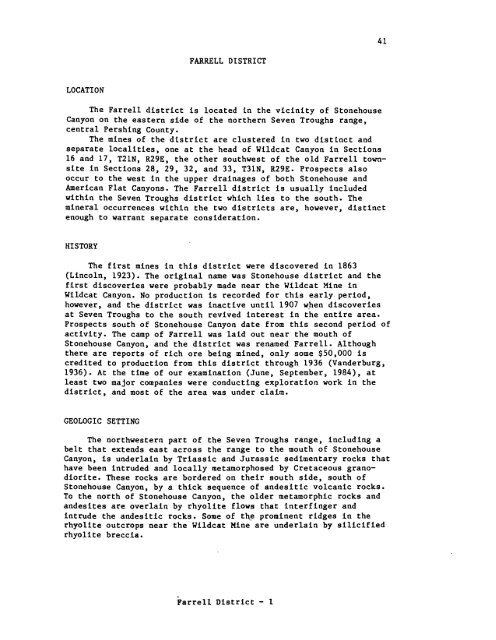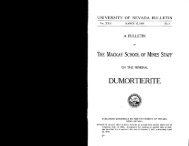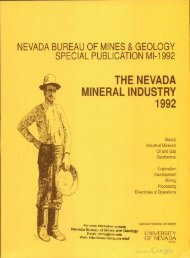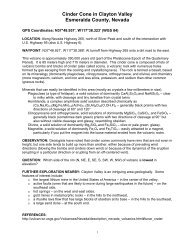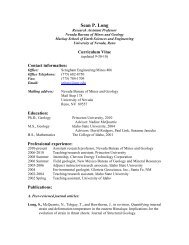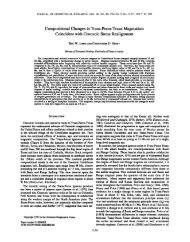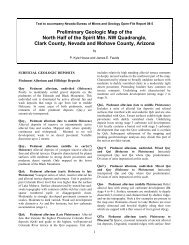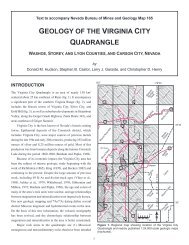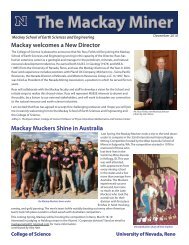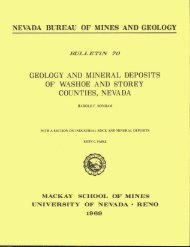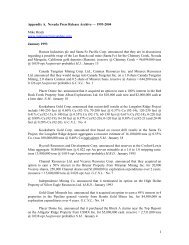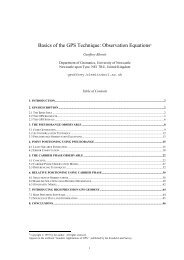Nevada Bureau of Mines and Geology - University of Nevada, Reno
Nevada Bureau of Mines and Geology - University of Nevada, Reno
Nevada Bureau of Mines and Geology - University of Nevada, Reno
You also want an ePaper? Increase the reach of your titles
YUMPU automatically turns print PDFs into web optimized ePapers that Google loves.
LOCATION<br />
FARRELL DISTRICT<br />
The Farrell district is located in the vicinity <strong>of</strong> Stonehouse<br />
Canyon on the eastern side <strong>of</strong> the northern Seven Troughs range,<br />
central Pershing County.<br />
The mines <strong>of</strong> the district are clustered in two distinct <strong>and</strong><br />
separate localities, one at the head <strong>of</strong> Wildcat Canyon in Sections<br />
16 <strong>and</strong> 17, T21N, R29E, the other southwest <strong>of</strong> the old Farrell tom-<br />
site in Sections 28, 29, 32, <strong>and</strong> 33, T31N, R29E. Prospects also<br />
occur to the west in the upper drainages <strong>of</strong> both Stonehouse <strong>and</strong><br />
American Flat Canyons. The Farrell district is usually included<br />
within the Seven Troughs district which lies to the south. The<br />
mineral occurrences within the two districts are, however, distinct<br />
enough to warrant separate consideration.<br />
HISTORY<br />
The first mines in this district were discovered in 1863<br />
(Lincoln, 1923). The original name was Stonehouse district <strong>and</strong> the<br />
first discoveries were probably made near the Wildcat Mine in<br />
Wildcat Canyon. No production is recorded for this early period,<br />
however, <strong>and</strong> the district was inactive until 1907 when discoveries<br />
at Seven Troughs to the south revived interest in the entire area.<br />
Prospects south <strong>of</strong> Stonehouse Canyon date from this second period <strong>of</strong><br />
activity. The camp <strong>of</strong> Farrell was laid out near the mouth <strong>of</strong><br />
Stonehouse Canyon, <strong>and</strong> the district was renamed Farrell. Although<br />
there are reports <strong>of</strong> rich ore being mined, only some $50,000 is<br />
credited to production from this district through 1936 (V<strong>and</strong>erburg,<br />
1936). At the time <strong>of</strong> our examination (June, September, 1984), at<br />
least two major companies were conducting exploration work in the<br />
district, <strong>and</strong> most <strong>of</strong> the area was under claim.<br />
GEOLOGIC SETTING<br />
The northwestern part <strong>of</strong> the Seven Troughs range, including a<br />
belt that extends east across the range to the mouth <strong>of</strong> Stonehouse<br />
Canyon, is underlain by Triassic <strong>and</strong> Jurassic sedimentary rocks that<br />
have been intruded <strong>and</strong> locally metamorphosed by Cretaceous grano-<br />
diorite. These rocks are bordered on their south side, south <strong>of</strong><br />
Stonehouse Canyon, by a thick sequence <strong>of</strong> <strong>and</strong>esitic volcanic rocks.<br />
To the north <strong>of</strong> Stonehouse Canyon, the older metamorphic rocks <strong>and</strong><br />
<strong>and</strong>esites are overlain by rhyolite flows that interfinger <strong>and</strong><br />
intrude the <strong>and</strong>esitic rocks. Some <strong>of</strong> th.e prominent ridges in the<br />
rhyolite outcrops near the Wildcat Mine are underlain by silicified<br />
rhyolite breccia.<br />
Farre11 District - 1


